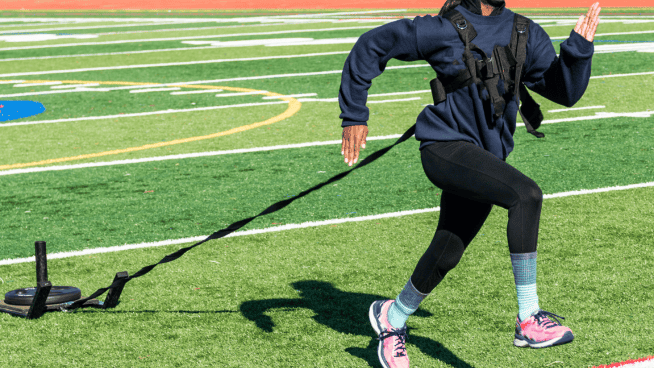Are You Planking Your Way Into Back Pain?
You might think the Plank exercise is easy. If so, you’re probably doing it wrong.
If you think being strong means you can hold a Plank for as long as it takes to watch a sitcom, you’re for sure doing it wrong.
Despite what you might think about the “Planking craze” from way back, or the recent flurry of world record attempts, the Plank was never meant to be a half-engaged hold to be maintained for minutes or even hours on end. In fact, many top performance coaches and spine researchers say that long-duration holds do more harm than good.
See 27 Core Exercises We Love. (Are You Doing Them?)
Perhaps because it’s easy to measure time and hard to measure muscle engagement, duration has become the metric most people use when they gauge the success of a Plank.
That’s not only an incorrect view of the exercise, it’s also really bad news for your back.
Why World Record Plank Holds are All Wrong
You remember the headlines shouting about those unbelievable feats. One said, “Crazy man holds a Plank for five hours!” (paraphrasing). The next one screamed, “Even crazier man Planks for eight!”
Listen, we’re not trying to take anything away from George Hood (the 5-hour guy) or Mao Weidong (the 8-hour one). They pulled off impressive displays of strength—mental strength. But they didn’t do anything you should even think about modeling with your own core training.
Look again at the photos from their record attempts. Let’s start with Hood:

Notice the dramatic curve in his back. His belly hanging toward the floor creates a big lumbar lordosis, while his upper back seems to compensate with an even more exaggerated thoracic kyphosis.
What do those complicated-sounding anatomy terms mean? Quick definitions:
- Lordosis, from a Greek word meaning “bent backward,” refers to the inward curve of the lower back and cervical spine (neck). Too much of a low back curve is called lumbar hyperlordosis, or hollow back.
- Kyphosis is derived from a Greek word that means “hump.” There should naturally be a kyphosis in your thoracic spine, or mid- to upper back. But too much of it can lead to—you guessed it—a “hump” back.
What’s another way of saying “hump” back? Hunchback.
In simple terms, the position Hood is holding in the above photo above—and reinforcing for several hours—is a lot like a hunchback.
5 Other Really Big Mistakes People Make With Their Core Training
Now for Mao:

The new world record holder doesn’t look as hunchy as his American rival. His body forms a straighter line, and there’s less of a kyphosis in his upper back. But he still has a hollow back going on.
His rectus abdominus—what most of us know as our “abs”—are still swooping down toward the floor. That tells you those muscles aren’t doing a whole lot.
How Bad Planks Hurt Your Back
Look at photos of normal people planking, and you’ll see some version of these form faults over and over again: large curves in the back, belly sagging toward the ground.
When you’re in that position, “you’re no longer using your abdominal muscles,” says Mike Robertson, M.S., C.S.C.S. and owner of Indianapolis Fitness and Sports Training (IFAST). “You are literally jamming your lumbar spinous process [bony protrusions that point behind you] together to crate stability.”
Robertson explains that when Mao or Hood or anyone else gets into that swooped back position when planking, they are just “hanging out” on their lumbar spine—and holding it as long they can stand it.

Does that develop mental toughness? Maybe. But it’s not a great way to build strength or improve your core stability—which was supposed to be the whole point of Planks in the first place.
Worse, extended sag time reinforces what Robertson, other coaches and trainers, and the Postural Restoration Institute all describe as “extended posture.” You’ve no doubt seen the look it produces: Chest or belly way out in front, ribcage flared out, and butt jutting out behind.
The position causes a host of problems:
- The “butt-out” tilted pelvis lengthens the hamstrings, so they feel “tight.”
- Internally, the diaphragm flattens out, making it less effective at doing it’s job of driving respiration. (Yes, this position makes it harder to breathe in a sense.)
- The exaggerated curve in the back places an unbalanced load on the cartilage discs that separate the vertebrae, making them more susceptible to bulging or rupturing.
“Whether you have dysfunction or pain [in your back] now or not, you could definitely be driving into it if you’re planking in that [sagging belly] position for long periods of time,” Robertson says.
The Right Way to Plank
For the complex web of problems that bad planks can cause, there’s a cheap and simple solution. And it starts at your local hardware store.
“I always use a PVC pipe for Planks,” Robertson says. “It’s the best way to do it correctly.”
The PVC pipe is a simple way to keep yourself (or a client) honest during the Plank exercise. The goal is to have three points of contact with the pipe: head, upper back, and buttocks should all be in contact with the pipe. But—and here’s a key thing to note—there shouldn’t be a whole lot of space between the pipe and your lower back.
Properly executed, the plank looks like this:

When you’re in this position, “it’s a totally different exercise,” Robertson says. “Your transverse abdominis, your internal obliques, your external obliques—all those muscles that have a lot of real estate on the rib cage and the pelvis will be a lot more engaged.”
One thing to note about the strict Plank pictured above is the athlete’s arm position. Both forearms are held parallel to the body. Her hands are in a straight line in front of her, not clasped together forming a “V.” And her elbows are directly beneath her shoulders.

“You want to think about reaching long through your elbows,” Robertson says. “That drives your ribcage back, which is really important. A lot of times people get extended through their upper back, so if we can teach them to drive their ribcage back, that helps restores the natural kyphosis they need through their upper back.
“But the other thing that happens when you drive long through the elbows is that it helps reposition the lower ribcage over the pelvis and the pelvic floor. And ultimately that’s what we’re going for: we want to create that canister-type position (ribs down, pelvis up) through the midsection.”
Robertson says that if you do not have a PVC pipe, a broomstick will work in a pinch. You can also use a mirror if you’re stuck without any gear, but Robertson urges caution. He says, “You don’t want to be cranking your neck every which way trying to check out your own form.”
On your first try, you may find that it’s not possible to get your head, upper back and butt all in contact. If that’s the case, don’t worry. Work on it over time, and your position will improve.
Lastly—and you probably saw this coming—don’t set out to hold the plank for several minutes at a time. At least not at first.
“A lot of times, we’ll start with 30 seconds.” Robertson says. “We’ll have people who think they’re very good at Planks try this and find that 30 to 45 seconds absolutely crushes them.”
The Plank Exercise: Step-by-Step Coaching Points

- Use a PVC pipe to keep yourself honest.
- Place your elbows underneath your shoulders and flatten your forearms against the ground. Point your forearms straight ahead. Do not clasp your hands together or form a “A” with your forearms.
- Lift your torso off the ground, pushing out through your heels. Your heels should be behind your toes.
- Place the PVC pipe on the ridge between your buttocks. If you’re performing the move correctly, your buttocks, upper back and head will all touch the PVC pipe.
- Make sure your lower back has a slight dip in it. A friend or coach should only be able to slide his fingertips between your back and the pipe.
- You’ll might need to adjust your shoulders and core to achieve proper alignment. And if it’s impossible to get on your first go-around, no worries. Work on it over time.
- Hold for 30 seconds. Perform 2-4 sets.
READ MORE:
5 Painful Mistakes People Make With Their Core Training
27 Coach-Approved Core Exercises You Should Be Doing
See the Ultimate Test of Core Strength (Advanced Athletes Only!)
RECOMMENDED FOR YOU
MOST POPULAR
Are You Planking Your Way Into Back Pain?
You might think the Plank exercise is easy. If so, you’re probably doing it wrong.
If you think being strong means you can hold a Plank for as long as it takes to watch a sitcom, you’re for sure doing it wrong.
Despite what you might think about the “Planking craze” from way back, or the recent flurry of world record attempts, the Plank was never meant to be a half-engaged hold to be maintained for minutes or even hours on end. In fact, many top performance coaches and spine researchers say that long-duration holds do more harm than good.
See 27 Core Exercises We Love. (Are You Doing Them?)
Perhaps because it’s easy to measure time and hard to measure muscle engagement, duration has become the metric most people use when they gauge the success of a Plank.
That’s not only an incorrect view of the exercise, it’s also really bad news for your back.
Why World Record Plank Holds are All Wrong
You remember the headlines shouting about those unbelievable feats. One said, “Crazy man holds a Plank for five hours!” (paraphrasing). The next one screamed, “Even crazier man Planks for eight!”
Listen, we’re not trying to take anything away from George Hood (the 5-hour guy) or Mao Weidong (the 8-hour one). They pulled off impressive displays of strength—mental strength. But they didn’t do anything you should even think about modeling with your own core training.
Look again at the photos from their record attempts. Let’s start with Hood:

Notice the dramatic curve in his back. His belly hanging toward the floor creates a big lumbar lordosis, while his upper back seems to compensate with an even more exaggerated thoracic kyphosis.
What do those complicated-sounding anatomy terms mean? Quick definitions:
- Lordosis, from a Greek word meaning “bent backward,” refers to the inward curve of the lower back and cervical spine (neck). Too much of a low back curve is called lumbar hyperlordosis, or hollow back.
- Kyphosis is derived from a Greek word that means “hump.” There should naturally be a kyphosis in your thoracic spine, or mid- to upper back. But too much of it can lead to—you guessed it—a “hump” back.
What’s another way of saying “hump” back? Hunchback.
In simple terms, the position Hood is holding in the above photo above—and reinforcing for several hours—is a lot like a hunchback.
5 Other Really Big Mistakes People Make With Their Core Training
Now for Mao:

The new world record holder doesn’t look as hunchy as his American rival. His body forms a straighter line, and there’s less of a kyphosis in his upper back. But he still has a hollow back going on.
His rectus abdominus—what most of us know as our “abs”—are still swooping down toward the floor. That tells you those muscles aren’t doing a whole lot.
How Bad Planks Hurt Your Back
Look at photos of normal people planking, and you’ll see some version of these form faults over and over again: large curves in the back, belly sagging toward the ground.
When you’re in that position, “you’re no longer using your abdominal muscles,” says Mike Robertson, M.S., C.S.C.S. and owner of Indianapolis Fitness and Sports Training (IFAST). “You are literally jamming your lumbar spinous process [bony protrusions that point behind you] together to crate stability.”
Robertson explains that when Mao or Hood or anyone else gets into that swooped back position when planking, they are just “hanging out” on their lumbar spine—and holding it as long they can stand it.

Does that develop mental toughness? Maybe. But it’s not a great way to build strength or improve your core stability—which was supposed to be the whole point of Planks in the first place.
Worse, extended sag time reinforces what Robertson, other coaches and trainers, and the Postural Restoration Institute all describe as “extended posture.” You’ve no doubt seen the look it produces: Chest or belly way out in front, ribcage flared out, and butt jutting out behind.
The position causes a host of problems:
- The “butt-out” tilted pelvis lengthens the hamstrings, so they feel “tight.”
- Internally, the diaphragm flattens out, making it less effective at doing it’s job of driving respiration. (Yes, this position makes it harder to breathe in a sense.)
- The exaggerated curve in the back places an unbalanced load on the cartilage discs that separate the vertebrae, making them more susceptible to bulging or rupturing.
“Whether you have dysfunction or pain [in your back] now or not, you could definitely be driving into it if you’re planking in that [sagging belly] position for long periods of time,” Robertson says.
The Right Way to Plank
For the complex web of problems that bad planks can cause, there’s a cheap and simple solution. And it starts at your local hardware store.
“I always use a PVC pipe for Planks,” Robertson says. “It’s the best way to do it correctly.”
The PVC pipe is a simple way to keep yourself (or a client) honest during the Plank exercise. The goal is to have three points of contact with the pipe: head, upper back, and buttocks should all be in contact with the pipe. But—and here’s a key thing to note—there shouldn’t be a whole lot of space between the pipe and your lower back.
Properly executed, the plank looks like this:

When you’re in this position, “it’s a totally different exercise,” Robertson says. “Your transverse abdominis, your internal obliques, your external obliques—all those muscles that have a lot of real estate on the rib cage and the pelvis will be a lot more engaged.”
One thing to note about the strict Plank pictured above is the athlete’s arm position. Both forearms are held parallel to the body. Her hands are in a straight line in front of her, not clasped together forming a “V.” And her elbows are directly beneath her shoulders.

“You want to think about reaching long through your elbows,” Robertson says. “That drives your ribcage back, which is really important. A lot of times people get extended through their upper back, so if we can teach them to drive their ribcage back, that helps restores the natural kyphosis they need through their upper back.
“But the other thing that happens when you drive long through the elbows is that it helps reposition the lower ribcage over the pelvis and the pelvic floor. And ultimately that’s what we’re going for: we want to create that canister-type position (ribs down, pelvis up) through the midsection.”
Robertson says that if you do not have a PVC pipe, a broomstick will work in a pinch. You can also use a mirror if you’re stuck without any gear, but Robertson urges caution. He says, “You don’t want to be cranking your neck every which way trying to check out your own form.”
On your first try, you may find that it’s not possible to get your head, upper back and butt all in contact. If that’s the case, don’t worry. Work on it over time, and your position will improve.
Lastly—and you probably saw this coming—don’t set out to hold the plank for several minutes at a time. At least not at first.
“A lot of times, we’ll start with 30 seconds.” Robertson says. “We’ll have people who think they’re very good at Planks try this and find that 30 to 45 seconds absolutely crushes them.”
The Plank Exercise: Step-by-Step Coaching Points

- Use a PVC pipe to keep yourself honest.
- Place your elbows underneath your shoulders and flatten your forearms against the ground. Point your forearms straight ahead. Do not clasp your hands together or form a “A” with your forearms.
- Lift your torso off the ground, pushing out through your heels. Your heels should be behind your toes.
- Place the PVC pipe on the ridge between your buttocks. If you’re performing the move correctly, your buttocks, upper back and head will all touch the PVC pipe.
- Make sure your lower back has a slight dip in it. A friend or coach should only be able to slide his fingertips between your back and the pipe.
- You’ll might need to adjust your shoulders and core to achieve proper alignment. And if it’s impossible to get on your first go-around, no worries. Work on it over time.
- Hold for 30 seconds. Perform 2-4 sets.
READ MORE:
5 Painful Mistakes People Make With Their Core Training
27 Coach-Approved Core Exercises You Should Be Doing
See the Ultimate Test of Core Strength (Advanced Athletes Only!)










